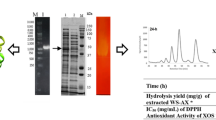Abstract
Fractionation of extracellular xylan hydrolases of a strain ofStreptomyces exfoliatus MC1 (by salting out, molecular sieving and ion exchange chromatography) revealed the presence of five species of the enzyme. Three major fractions could be purified to homogeneity; two were apparently endohydrolases and the third an exo-xylan hydrolase. The three fractions showed different degrees of affinity to the substrate and differed considerably in their substrate specificities. One of the endo-enzymes was specific to xylan while the other could also attack cellulose, inulin and pectin. The exo-enzyme showed xylanolytic and cellulolytic functions only. The three fractions further differed in their response to the presence of metal ions, mercapto reagents and compounds. Although the pH and temperature optima were different, the three fractions functioned synergistically in the hydrolysis of xylan.
Similar content being viewed by others
References
Bernfeld D.: Amylases α and β, p. 149 inMethods in Enzymology, Vol. 1 (S. P. Colowick, N. O. Kaplan, Eds). Academic Press, New York 1955.
Davis B. J.: Disc electrophoresis. II. Method and application to human serum proteins.Ann. N. Y. Acad. Sci. 121, 404 (1964).
Dekker R. F. H., Richards G. N.: Purification, properties and mode of action of hemicellulase I produced byCeratocystic paradoxa.Carbohydrate Res. 39, 97 (1975a).
Dekker F. R. H., Richards G. N.: Purification, properties and mode of action of hemicellulase II produced byCeratocystis paradoxa.Carbohydrate Res. 42, 107 (1975b).
Dekker R. F. H., Richards G. N.: Hemicellulases.Adv. Carbohydrate Chem. Biochem. 32, 278 (1976).
Dixon M., Webb E. C.: Table of enzymes, p. 683 inEnzymes, 3rd Edition. Longman group 1979.
Fukui S., Sato M.: Xylanase system ofAspergillus batatae.Bull. Agr. Chem. Soc. Japan 21, 392 (1957).
Fukumoto J., Tsujisaka Y., Takenishi S.: Hemicellulases. I. Purification and some properties of hemicellulases fromAspergillus niger, Nippon Nogeikagaku Kaishi 44, 447 (1970);Chem. Abstr. 74, 107516c (1971).
Gorbacheva I. V., Rodionova N. A.: Purification and characterisation of endo-(1–4)-β-xylanase fromAspergillus niger p. 227 inBioconversion of Cellulosic Substances into Energy Chemicals and Microbial Protein (T. K. Ghose, Ed.). Thompson Press (India) Faridabad 1978.
Hashimoto S., Muramatsu T., Funatsu M.: Studies on xylanase fromTrichoderma viridae. Part I. Isolation and some properties of crystalline xylanase.Agr. Biol. Chem.,35, 501 (1971).
Horrocks R.H.: Paper partition chromatography of reducing sugars with benzidine as a spraying reagent.Nature 164, 444 (1949).
Iwamoto T., Sasaki T., Inaoka M.: Kinds of xylanase fromAspergillus niger.Mem. Ehime Univ. 17, 185 (1973);Chem. Abstr. 79, 89235g (1873).
Kertesz Z.I.: Pectic enzymes, p. 333 inThe Pestic Substances. Interscience Publishers, New York 1951.
Little C., Sanner T., Pihl A.: Stimulation of fructose 1,6-diphosphatase by sulfhydryl reagents and interaction between the different enzymic sites in the molecule.Eur. J. Biochem.,8, 229 (1969).
Lowry O.H., Rosenbrough N.J., Farr A.L., Randall R.J.: Protein measurement with the Folin phenol reagent.J. Biol. Chem. 193, 265 (1951).
Mandels M., Weber J.: The production of cellulases, p. 391in Cellulases and Their Application. Vol. 95 (O.F. Gould, Ed.). Advances in Chemistry Series. Americal Chemical Society Publications, Washington 1969.
Marshall J.J., Whelan W.J.: Detection of endo-acting carbohydrases, particularly in the presence of exoenzymes acting on the same substrate.Anal. Biochem.,43, 316 (1971).
Nelson T.E., Scaletti J.V., Smith F., Kirkwood S.: The use of enzymes in structural studies on polysaccharides.Can. J. Chem.,41, 167 (1963).
Smith E.E., Drummond G.S., Marshall J.J., Whelan W.J.: Determination of carbohydrase action pattern with periodate oxidised polysaccharides.Fed. Proc. 29, 930 (1970).
Sreenath H.K., Joseph R., Murthy V.S.: Studies on xylan hydrolases from different strains ofStreptomyces and their mutual influences in the breakdown of xylan.Folia Microbiol. 23, 299 (1978).
Whistler R.L., Masak E.: Enzymatic hydrolysis of xylan.J. Am. Chem. Soc.,77, 1241 (1955).
Author information
Authors and Affiliations
Rights and permissions
About this article
Cite this article
Sreenath, H.K., Joseph, R. Purification and properties of extracellular xylan hydrolases ofStreptomyces exfoliatus . Folia Microbiol 27, 107–115 (1982). https://doi.org/10.1007/BF02879768
Received:
Revised:
Issue Date:
DOI: https://doi.org/10.1007/BF02879768




